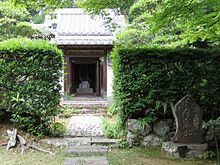This article needs additional citations for verification. (August 2021) |
Lady Tsukiyama or Tsukiyama-dono (築山殿, d. 19 September 1579) was a Japanese noble lady and aristocrat from the Sengoku period. She was the chief consort of Tokugawa Ieyasu, the daimyō who would become the founder and first shōgun of the Tokugawa shogunate. She was the mother of Ieyasu's first child, Kamehime, and gave birth to Ieyasu's heir apparent, Matsudaira Nobuyasu. As principal consort, Tsukiyama led many of the political achievements of the former Matsudaira clan. She was an important figure at the beginning of Ieyasu's career, who later led to the beginning of Tokugawa Shogunate. She is best known for possibly initiating a conspiracy against Oda Nobunaga. Whether or not she cheated Ieyasu into joining the Takeda clan; the veracity of this event remains one of the greatest mysteries of the Sengoku period, known as the Nobuyasu Incident.
Lady Tsukiyama | |
|---|---|
 | |
| Died | 19 September 1579 |
| Resting place | Seirai'in Temple |
| Spouse | Tokugawa Ieyasu |
| Children |
|
| Family |
|
Life
editLady Tsukiyama was the daughter of Sekiguchi Chikanaga, an Imagawa retainer. Her mother was Imagawa Yoshimoto's former concubine and daughter of Ii Naohira. Lady Tsukiyama was also known as Sena (瀬名) before she married Tokugawa Ieyasu. Sena was related to Ii Naotora who was the female lord of Ii clan. Sena's actions were vital for the Ii clan to ally with Ieyasu. The Ii family members became one of the most important retainers of the Tokugawa shogunate.
In January 1557, Lady Tsukiyama married Tokugawa Ieyasu. The marriage was arranged by Imagawa Yoshimoto, ostensibly to help cement ties between the Imagawa clan and the Tokugawa clan. Two years later, on 13 March 1559, she gave birth to Ieyasu's eldest son, Matsudaira Nobuyasu.[1] In 1560, she gave birth to a daughter, Kamehime.
When Ieyasu moved to Hamamatsu in 1570, he left Lady Tsukiyama and their eldest son at Okazaki Castle. During this time, he had started an affair with Lady Saigō. In 1573, one of Tsukiyama's maid servants, Oman, became pregnant by Ieyasu. Oman bore him a son, Hideyasu, though Ieyasu was slow to claim lest it anger his wife.

Because Nobuyasu had no sons by his wife Tokuhime, a daughter of Oda Nobunaga, Lady Tsukiyama decided to procure a daughter of a Takeda retainer for her son's concubine. Seeing this and all of the conflicts that her mother-in-law made against her, Tokuhime sent a letter to her father, telling him that Lady Tsukiyama was conspiring with the Takeda clan against the Oda clan. Oda Nobunaga informed Ieyasu of this letter, and as a show of good faith and loyalty, and to preserve the Oda-Tokugawa alliance, Ieyasu ordered his wife executed, and Nobuyasu imprisoned due to his closeness with his mother.
On 19 September 1579, Lady Tsukiyama was beheaded on the shore of Lake Sanaru, in Hamamatsu. Her primary grave is at Seiryū temple (清流寺) in Tenryu ward, Hamamatsu. Her head was sent to Okazaki and interred at Yūden temple (祐傳寺); during the Tenpō era (1830–1844) it was transferred to Yahashira Shrine (八柱神社).[2]
Knowing his eldest son would feel obligated to avenge his late mother's death, Ieyasu eventually ordered Nobuyasu, who was confined at Futamata Castle (now Tenryū Ward, Hamamatsu), to commit suicide (seppuku) on 5 October 1579. His Buddhist name is Shoge-in.[citation needed]
Theory about Tsukiyama's execution
editThe commonly believed theory regarding Tsukiyama's execution were though that Nobunaga was the one who ordered the execution. However, modern era Japanese historian Motoki Kuroda challenged this theory by stating several facts, that it was Ieyasu himself who ordered the execution, based on several evidences from Ieyasu's personal letter and also "Azuchi diary" record. On the other hand, Kuroda also stated that the stor about Nobunaga as the one who order the execution solely based on "Mikawa Monogatari". Other historians and Sengoku period experts such as Katsuhiro Taniguchi , Takanari Honda , Masaru Hirayama and Hiroyuki Shiba also stated the fact that this executions were Ieyasu's initiative as to suppress the rebellious faction within Tokugawa clan who preferred to ally with the Takeda clan and defied Oda Nobunaga. Such faction was masterminded by Tsukiyama and her son, Nobuyasu, which considered by Ieyasu as problematic as they have implied their collaboration with the Takeda clan even before the Battle of Nagashino.[3]
Popular culture
edit- Nanao portrayed her in the 2017 NHK Taiga drama Naotora: The Lady Warlord (おんな城主 直虎).
- Lady Tsukiyama appears as a playable character in the 2021 Koei Tecmo game Samurai Warriors 5.[4]
- Kasumi Arimura portrays her (from youth to adulthood) in the 2023 NHK Taiga drama What Will You Do, Ieyasu?, opposite Jun Matsumoto as Takechiyo/Ieyasu.
References
edit- ^ Totman, Conrad (1983). Tokugawa Ieyasu, Shogun: A Biography. Heian. p. 32. ISBN 9780893462109.
- ^ "八柱神社". City of Okazaki Official Tourism Board.
- ^ Motoki Kuroda (黒田基樹) (2023). "なぜ徳川家康は正妻と嫡男を自害させたのか…戦国時代にも存在した「上司への忖度」という悲劇" [Why did Ieyasu Tokugawa kill his wife and his legitimate son?]. President Online (in Japanese). President Inc. pp. 1–4. Retrieved 30 June 2024.
- ^ "SAMURAI WARRIORS 5". Samurai Warriors 5. Retrieved 24 March 2021.